 |
Consequences of Vatican II
Spanish Religious Orders on the
Path of Death
Mark Stabinski
I recently came across a summary of today’s “restructuring” of the major Religious Orders in Spain. This restructuring is imperative due to their admitted internal crisis: “the lack of new vocations, aged members and identity crisis.” To save their own faces and that of Vatican II, however, the Orders are calling their decision to close many of their houses a “revitalization.”
A look at the religious attending the recent assemblies and provincial meetings of the Spanish Orders says it all. Almost every priest is dressed in lay clothing, without any religious characteristic. The world has invaded their Orders. One has no sense they are looking for a restoration of what they once were, that is, the strongest force of resistance to the world in the Catholic Church.
The Spanish religious clergy survived the Communist Civil War of 1936 but they could not withstand the spirit of the Vatican II.
Jesuits
Responding to a proposal by the Jesuit Provincial of the five Provinces of the Society of Jesus in Spain (Aragon, Andalusia or Betica, Castile, Loyola and Tarragona), The Society’s General Fr. Adolfo Nicolas announced they will be consolidated into a single Province, the “Province of Spain,” in 2014.
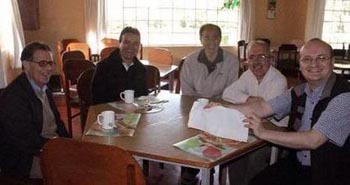
Jesuit chapter members at the 2012 meeting |
Fr. Nicolas called this option “the greatest and best service to the Church and society."
At left, you can see the provincial leaders at the 2012 meeting giving frozen smiles to the camera, while they calculate the catastrophe caused by Vatican II in their once flourishing Order. They are dressed casually, with no mark to distinguish them as Jesuits. They look like anything but the soldiers of the Church Militant envisioned by St. Ignatius Loyola.
Capuchins
The Capuchins, as we know, was one of the most active branches of the Franciscan Order. So much so, that they constitute their own Order inside of the Franciscan family. The Capuchins of Spain have already begun their process of unification. In 2011 the four provinces of Andalusia, Castile, Navarra-Cantabria-Aragon and Valencia were also unified into a single province.
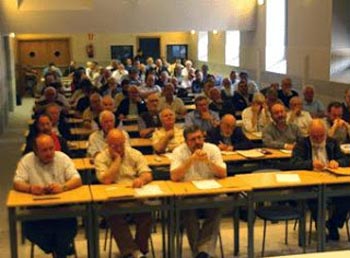
Capuchins gather to discuss a radical consolidation |
The Order of Capuchin Friars Minor is one of the chief offshoots of the Franciscans, which sought to return to the primitive rule of solitude and penance envisaged by St. Francis of Assisi. By the early 1600s, they had 1,500 houses divided into 50 provinces in Europe and were one of the chief tools in the Catholic Counter Reformation.
Now, the Capuchin priests, a group of aged men pretending to be modern, clearly do not attract vocations. After Vatican II, the original Rule of the Order was abandoned and the Capuchin houses throughout Spain have emptied.
Franciscans
Not only the Capuchins, but the main trunk of the Franciscan family, the Franciscan Order itself, is also changing. Thirty-nine representatives of seven of their Provinces in Spain met in September 2012 to discuss their “restructuring and revitalization.”
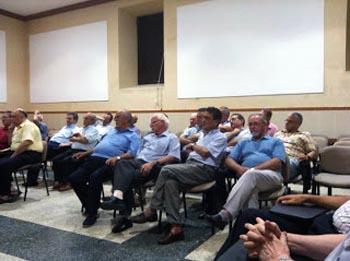
A relaxed air to discuss the change; below, praying together at Mass
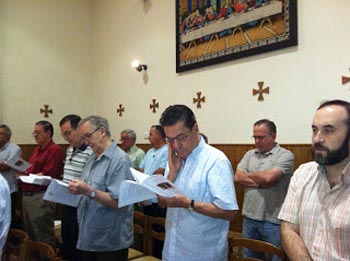 |
They decided that the Provinces of Castile, Andalusia, Granada, Valencia-Aragon, Catalonia, Cartagena-Murcia and the Custody of San Francisco Solano should be consolidated into a single entity by the year 2015. The Provinces of Aránzazu and Santiago will remain as they are.
At right, we see some of the Provincial Heads at a meeting discussing the change. Their posture indicates they have adapted completely to the spirit of the world. Few young men would aspire to become mendicant friars upon seeing these models. Openness to the world has had its destructive toll on post-conciliar vocations.
Before Vatican II, the Church combated the bad influences of the world. After the Council the Church embraced the world as an instrument of Revelation. The Church became one with the world. This had an immediate consequence in the apostolate: Why would anyone want to give up their entire lives to be with people who live exactly like a modern man lives in the world?
In the lower picture at right, we see the Franciscans assisting at the Mass at their Provincial meeting. It is hardly the picture of the monks of St. Francis in their brown habits chanting in the choir rows. There is no uniformity in dress or action. It is the spirit of the world in the new progressivist Franciscan mentality.
Discalced Carmelites
During Easter Week of 2011, the Discalced Carmelites of the six Provinces of Spain held their Provincial Chapters. These six Provinces are to be immersed in a “restructuring” process to create, like the Jesuits, a single Spanish Province.
In the last census of May 2010, there were 433 Discalced Carmelites in Spain and Portugal: 230 were above 60 years of age, of these 92 were more than 80 years old. Among the remaining 203 below 60 years of age, only 25 were below 40 years old. There are 78 Carmelite monasteries in Spain and Portugal, of these, 58 have only six or less religious men.
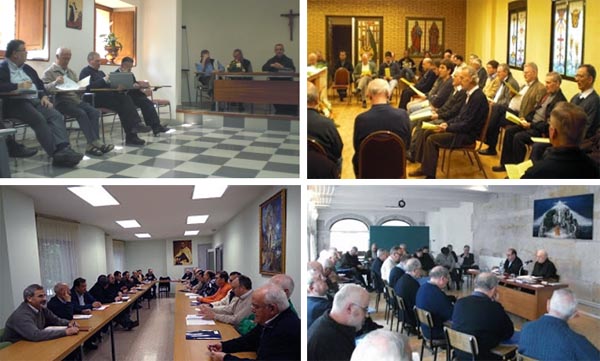
Discalced Carmelite meetings in the provinces of Aragon-Valencia, Aragon, Burgos and Navarre |
In the pictures above top left we see the Discalced Carmelites at the Chapter of the Province of Aragon-Valencia discussing the change; top right, the Chapter of the Province of Aragon, 2010, at a moment of praying together. Bottom left, the Chapter of the Province of Burgos; right, the Chapter of the Province of Navarre is assembled under a modernist picture. In none of these Chapter meetings do we notice a statue of Our Lady of Mount Carmel.
This association of older men that replaced the Order of the Virgin presents a picture of mediocrity. The physiognomy of the Discalced Carmelites has faded beyond recognition. Reformed by St. John of the Cross with the collaboration of St. Teresa of Avila, the contemplative, penitent and militant spirit of those Saints is hardly recognizable in the faces of these men. As far as being discalced, which was the note of their Order to distinguish it from the other branches, none is discalced or wears a Carmelite habit, as can be seen in the photos.
One could say the Counter Reformation, born in Spain, now is dead.
Dominicans
In September 2012, the Dominican Council Boards, Priors, Superiors and officials of the Provinces of the Iberian Peninsula met in Avila. There they determined that in 2016, the 800th anniversary of the founding of the Friars Preachers, the Dominicans will unify the Provinces of Spain, Portugal and the Vicariate of the Holy Rosary into one single Province. Again, the practical reasons for the change are an aging religious population and lack of new vocations.
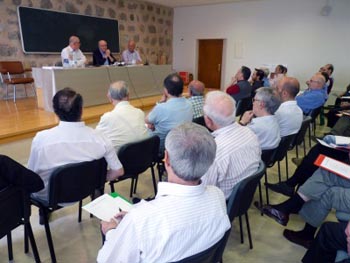
Spanish Dominicans meeting in Avila, 2012 |
At left, we see a meeting of Spanish Dominican Superiors in Avila in 2012. As they decide to close all these Provinces, they were listening to talks such as “A Sadistic God? Vicarious Satisfaction,” or “A Bungler God? Another Look at the Problem of Evil”
Again we find rows of men without religious habits. They could be attending a business meeting, except then they would at least have to wear coats and ties.
The fact is that the great Religious Orders, with their distinct gifts and traditions and their schools of spirituality, are on the road to disappearing. This situation in Spain, perhaps the most Catholic country in the world, is a symptom of how things are going everywhere.
The Religious Orders have been devastated by the wave of Progressivism that swept them after Vatican II. They set aside their rules, abandoned the spirit of their Founders, took up new social and environmental “missions” and abandoned their respective contemplative and militant lives.
This is how the great apostasy of Vatican II is destroying the sacred heritage that their Saint Founders passed down to these Orders.

Posted February 4, 2013

Related Topics of Interest
 Starting the Church of the Future in Vienna & Boston Starting the Church of the Future in Vienna & Boston
 Changing the Face of the Church Changing the Face of the Church
 Closing Churches: Incongruent Arguments Closing Churches: Incongruent Arguments
 Card. Schonborn's 'Prophecies' Card. Schonborn's 'Prophecies'
 Bishop Zdarsa's Trial Balloon Is Launched Bishop Zdarsa's Trial Balloon Is Launched
 Jesuits - High or Low Speed? Jesuits - High or Low Speed?

Related Works of Interest
|
|
Vatican II | Hot Topics | Home | Books | CDs | Search | Contact Us | Donate

© 2002-
Tradition in Action, Inc. All Rights Reserved
|
 |
|